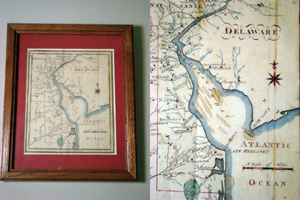
But for John and Sarah Avery, it wasn’t without some comforts.
It is likely, archaeologists believe, that the couple lived in a house near Rehoboth Bay and that the house had plaster walls.
What’s known of the Averys and their home place – Avery’s Rest – has come alive thanks to a detailed search of public records and a dig at a property just west of Rehoboth Beach.
Artifacts and a detailed story of Avery’s Rest will be on display beginning Saturday at the Rehoboth Beach Museum. The display will mark Archaeology Month in Delaware by showcasing more than four years of searching and digging and countless volunteer hours by members of the Sussex County chapter of the Archaeology Society of Delaware.
Avery’s Rest is one of the earliest settlements in Delaware – a place where real and lasting settlement came later than in nearby states, said Craig Lukezic, a state archaeologist.
It was nestled between Dutch and English settlements. And it even became a pawn among the English gentry who controlled land grants as they sought to control land ownership in the region, Lukezic said.
For all the work of state and volunteer archaeologists, the diggers still haven’t located the Avery house’s foundation. But the archaeologists did discover two wells and a cellar – probably of some type of storage building.
John Avery was one of Delaware’s early settlers, a sea captain, a possible raider of the Dutch settlement at Lewes and eventually a justice of the peace and judge.
He was also a landowner. When he died, he owned more than 900 acres around Rehoboth Bay.
The Avery’s Rest site, just west of Rehoboth Beach and near the upper end of Rehoboth Bay, is significant because it is an early settlement. The property was slated for development, and the owners gave state officials time to search the property for signs of the early settlers.
The project also set the stage for a cooperative effort between the state’s small group of professional archaeologists and volunteers with the archaeological society.
John Bransch, president of the Sussex Chapter of the Archaeological Society of Delaware, estimated that over the last four years – a period that included both digging on the site and conservation of the artifacts that were recovered – the group has logged more than 15,000 volunteer hours.
The work started slowly, until the team located two wells and began to find artifacts that pieced together the story of life at Avery’s Rest, he said.
While the area was remote and isolated, there was water access and local people would have used the water as a highway to travel, trade and visit, Lukezic said.
Local legend has it that Avery was a pirate – the Plymouth, England-born model for Daniel Defoe’s legendary hero in Life, Adventures and Pyracies of the Famous Captain Singleton. That John Avery pillaged and plundered in the Caribbean and along the coasts of Spain, Africa and Madagascar.
But it turns out, Lukezic said, that the dates for Rehoboth’s John Avery don’t match those of the buccaneer – whose life of piracy is believed to have begun in 1691.
Rehoboth’s John Avery was likely a successful and profitable landowner by more legal methods.
One thing the archaeologists found were lots of pig and cattle bones. The theory is that Avery may have been supplying other local residents with meat.
Former state director of historical and cultural affairs Daniel R. Griffith discovered the site in 1977, when state officials were doing survey work around Delaware’s Inland Bays. In 1978, it was listed on the National Register of Historic Places.
Griffith said at the time of its discovery that state archaeologists – fearing development would destroy any record of its historic sites – wanted an inventory of what was there.
Avery’s Rest, Griffith said, was in a tilled farm field. Soil stains at the site helped identify it as an early settlement.
The plaster that was found is unique, because typically at that time most homes would have been built entirely of wood, Lukezic said.
Among the artifacts they found were part of a horse bridle, a buckle, a pistol ball, flint – possibly from a pistol or a fire starter – and a knife, a fork and bits of pottery. They’ve also found bottles and many pieces of bones and other fragments.
State officials are keeping the site’s location a secret to avoid problems with artifact hunters.
The site is linked to one brief period in Delaware’s history of early European settlement – 1680 to 1720. Within that 40-year time frame, historians know that European settlers shifted from a life of scant possessions to an explosion in commerce sometime around 1700.
Then, “around 1720, this place was abandoned, for whatever reason,” Lukezic said.
Copyright 2010 Associated Press. All rights reserved. This material may not be published, broadcast, rewritten or redistributed.
AP-ES-04-28-10 1925EDT


